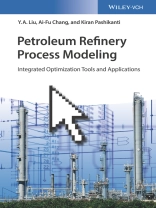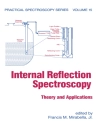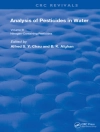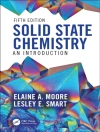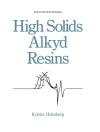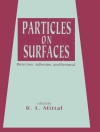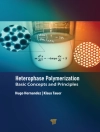A comprehensive review of the theory and practice of the simulation and optimization of the petroleum refining processes
Petroleum Refinery Process Modeling offers a thorough review of how to quantitatively model key refinery reaction and fractionation processes. The text introduces the basics of dealing with the thermodynamics and physical property predictions of hydrocarbon components in the context of process modeling. The authors – three experts on the topic – outline the procedures and include the key data required for building reaction and fractionation models with commercial software.
The text shows how to filter through the extensive data available at the refinery and using plant data to begin calibrating available models and extend the models to include key fractionation sub-models. It provides a sound and informed basis to understand and exploit plant phenomena to improve yield, consistency, and performance. In addition, the authors offer information on applying models in an overall refinery context through refinery planning based on linear programming. This important resource:
-Offers the basic information of thermodynamics and physical property predictions of hydrocarbon components in the context of process modeling
-Uses the key concepts of fractionation lumps and physical properties to develop detailed models and workflows for atmospheric (CDU) and vacuum (VDU) distillation units
-Discusses modeling FCC, catalytic reforming and hydroprocessing units
Written for chemical engineers, process engineers, and engineers for measurement and control, this resource explores the advanced simulation tools and techniques that are available to support experienced and aid new operators and engineers.
Mục lục
About the Authors xiii
Foreword by Lawrence B. Evans xv
Foreword by Steven R. Cope xvii
Preface xix
Acknowledgments xxiii
Scope of Textbook xxv
Software Selection and Copyright Notice xxvii
1 Characterization and Physical and Thermodynamic Properties of Oil Fractions 1
1.1 Crude Assay 1
1.1.1 Bulk Properties 2
1.1.2 Fractional Properties 6
1.1.3 Interconversion of Distillation Curves 7
1.2 Boiling Point-Based Hypothetical or Pseudocomponent Generation 8
1.3 Workshop 1.1 – Interconvert Distillation Curves 13
1.4 Workshop 1.2 – Extrapolate an Incomplete Distillation Curve 13
1.5 Workshop 1.3 – Calculate Me ABP of a Given Assay 13
1.6 Workshop 1.4 – Represent an Oil Fraction by the Old Oil Manager in Aspen HYSYS Petroleum Refining 16
1.7 Workshop 1.5 – Represent an Oil Fraction by the New Petroleum Assay Manager in Aspen HYSYS Petroleum Refining 25
1.8 Workshop 1.6 – Conversion from the Oil Manager to Petroleum Assay Manager and Improvements of the Petroleum Assay Manager over the Oil Manager 32
1.9 Property Requirements for Refinery Process Models 33
1.10 Physical Properties 36
1.10.1 Estimating Minimal Physical Properties for Pseudocomponents 36
1.10.2 Molecular Weight 37
1.10.3 Critical Properties 38
1.10.4 Liquid Density 40
1.10.5 Ideal Gas Heat Capacity 42
1.10.6 Other Derived Physical Properties 43
1.11 Process Thermodynamics 45
1.11.1 Process Thermodynamics 47
1.11.2 Mixed or Activity Coefficient-Based Approach 47
1.11.3 Equation-of-State Approach 49
1.12 Miscellaneous Physical Properties for Refinery Modeling 50
1.12.1 Two Approaches for Estimating Fuel Properties 51
1.12.2 Flash Point 52
1.12.3 Freeze Point 52
1.12.4 PNA Composition 53
1.13 Conclusion 54
Nomenclature 55
Bibliography 56
2 Atmospheric or Crude Distillation Unit (CDU) 59
2.1 Introduction 59
2.2 Scope of the Chapter 60
2.3 Process Overview 60
2.3.1 Desalting 61
2.3.2 Preheat Train and Heat Recovery 62
2.3.3 Atmospheric Distillation 62
2.4 Model Development 65
2.4.1 MESH Equations 66
2.4.2 Overall Column Efficiency and Murphree Stage Efficiency 66
2.4.3 Recommendation for Correctly Handling the Efficiency 68
2.4.4 Inside-Out Algorithm for Distillation Column Calculation Convergence 69
2.5 Feed Characterization 72
2.6 Data Requirements and Validation 73
2.7 A Representative Atmospheric Distillation Unit 76
2.8 Building the Model in Aspen HYSYS Petroleum Refining 77
2.8.1 Entering the Crude Information 78
2.8.2 Selection of a Thermodynamic Model 84
2.8.3 Crude Charge and Prefractionation Units 87
2.8.4 Atmospheric Distillation Column – Initial 88
2.8.5 Atmospheric Distillation Column – Side Strippers 95
2.8.6 Atmospheric Distillation Column – Pumparounds 98
2.8.7 Atmospheric Distillation Column – Adding Custom Stream Properties 101
2.8.8 Post-Convergence 104
2.9 Results 105
2.10 Model Applications to Process Optimization 109
2.10.1 Improve the 5% Distillation Point for an Individual Cut 109
2.10.2 Change Yield of a Given Cut 109
2.10.3 Workshop 2.1 – Perform Case Studies to Quantify the Effects of Stripping Steam Rate and Product Draw Rate 111
2.11 Workshop 2.2 – Rebuild Model Using “Backblending” Procedure 114
2.11.1 Import Distillation Data into Aspen HYSYS Oil Manager 115
2.11.2 Define a New Blend of the Backblended Crude Feed 116
2.11.3 Build the CDU Model Based on the Backblended Feed 120
2.11.4 Converging Column Model 120
2.11.5 Comparison of Results 123
2.12 Workshop 2.3 – Investigate Changes in Product Profiles with New Product Demands 126
2.12.1 Update Column Specifications 126
2.12.2 Vary Draw Rate of LGO 127
2.13 Workshop 2.4 – Investigate the Effects of Process Variables on Product Qualities 129
2.14 Workshop 2.5 – Application of Column Internal Tools (Column Hydraulic Analysis) 131
2.15 Workshop 2.6 – Application of the Petroleum Distillation Column 140
2.16 Conclusions 144
Nomenclature 145
Bibliography 145
3 Vacuum Distillation Unit 147
3.1 Process Description 147
3.2 Plant Data Reconciliation 149
3.2.1 Required Data 149
3.2.2 Representation of the Atmospheric Residue 149
3.2.3 Makeup of Gas Streams 152
3.3 Model Implementation 154
3.3.1 Plant Data and Modeling Approaches 155
3.3.2 Workshop 3.1 – Build the Simplified VDU Model 157
3.3.3 Workshop 3.2 – Build the Rigorous Model from a Simplified Model 165
3.4 Model Application – VDU Deep-Cut Operation 172
3.5 Workshop 3.3 – Simulation of the VDU Deep-Cut Operation 176
Bibliography 180
4 Predictive Modeling of the Fluid Catalytic Cracking (FCC) Process 183
4.1 Introduction 184
4.2 Process Description 185
4.2.1 Riser–Regenerator Complex 185
4.2.2 Downstream Fractionation 187
4.3 Process Chemistry 188
4.4 Literature Review 190
4.4.1 Kinetic Models 190
4.4.2 Unit-Level Models 193
4.5 Aspen HYSYS Petroleum Refining FCC Model 195
4.5.1 Slip Factor and Average Voidage 196
4.5.2 21-Lump Kinetic Model 197
4.5.3 Catalyst Deactivation 198
4.6 Calibrating the Aspen HYSYS Petroleum Refining FCC Model 199
4.7 Fractionation 200
4.8 Mapping Feed Information to Kinetic Lumps 203
4.8.1 Fitting Distillation Curves 203
4.8.2 Inferring Molecular Composition 205
4.8.3 Convert Kinetic Lumps to Fractionation Lumps 208
4.9 Overall Modeling Strategy 209
4.10 Results 211
4.11 Applications 220
4.11.1 Improving Gasoline Yield 220
4.11.2 Increasing Unit Throughput 223
4.11.3 Sulfur Content in Gasoline 224
4.12 Refinery Planning 225
4.13 Workshop 4.1 – Guide for Modeling FCC Units in Aspen HYSYS Petroleum Refining 231
4.13.1 Introduction 231
4.13.2 Process Overview 231
4.13.3 Process Data 231
4.13.4 Aspen HYSYS and Initial Component and Thermodynamics Setup 231
4.13.5 Basic FCC Model 238
4.13.6 FCC Feed Configuration 241
4.13.7 FCC Catalyst Configuration 246
4.13.8 FCC Operating Variable Configuration 250
4.13.9 Initial Model Solution 252
4.13.10 Viewing Model Results 253
4.14 Workshop 4.2 – Calibrating Basic FCC Model 258
4.15 Workshop 4.3 – Build the Model for Main Fractionator and Gas Plant System 267
4.15.1 T201_Main Fractionator 267
4.15.2 Overhead Wet Gas System, Primary Stripper Column T302_Stripper, and Debutanizer or Gasoline Stabilization Column T304_Stabilizer 275
4.15.3 T301_Absorber, Primary Absorber and T303_Re Absorber, Sponge Oil Absorber, or Reabsorption Column 281
4.16 Workshop 4.4 – Perform Case Studies to Quantify Effects of Key FCC Operating Variables 285
4.17 Workshop 4.5 – Generate Delta-Base Vectors for Linear Programming (LP)-Based Planning 291
4.18 Conclusions 297
Nomenclature 298
Bibliography 299
5 Predictive Modeling of Continuous Catalyst Regeneration (CCR) Reforming Process 303
5.1 Introduction 304
5.2 Process Overview 304
5.3 Process Chemistry 311
5.4 Literature Review 313
5.4.1 Kinetic Models and Networks 314
5.4.2 Unit-Level Models 317
5.5 Aspen HYSYS Petroleum Refining Catalytic Reformer Model 319
5.6 Thermophysical Properties 323
5.7 Fractionation System 323
5.8 Feed Characterization 324
5.9 Model Implementation 328
5.9.1 Data Consistency 329
5.9.2 Feed Characterization 330
5.9.3 Calibration 330
5.10 Overall Modeling Strategy 333
5.11 Results 335
5.12 Applications 340
5.12.1 Effect of Reactor Temperature on Process Yields 341
5.12.2 Effect of Feed Rate on Process Yields 344
5.12.3 Combined Effects on Process Yields 345
5.12.4 Effect of Feedstock Quality on Process Yields 346
5.12.5 Chemical Feedstock Production 347
5.12.6 Energy Utilization and Process Performance 349
5.13 Refinery Production Planning 350
5.14 Workshop 5.1 – Guide for Modeling CCR Units in Aspen HYSYS Petroleum Refining 354
5.14.1 Introduction 354
5.14.2 Process Overview and Relevant Data 354
5.14.3 Aspen HYSYS and Initial Component and Thermodynamic Setup 356
5.14.4 Basic Reformer Configuration 358
5.14.5 Input Feedstock and Process Variables 362
5.14.6 Solver Parameters and Running the Initial Model 368
5.14.7 Viewing Model Results 370
5.14.8 Updating Results with Molecular Composition Information 372
5.15 Workshop 5.2. – Model Calibration 376
5.16 Workshop 5.3 – Build a Downstream Fractionation System 387
5.17 Workshop 5.4. – Case Study to Vary RON and Product Distribution Profile 395
5.18 Conclusion 400
Nomenclature 400
Bibliography 402
6 Predictive Modeling of the Hydroprocessing Units 405
6.1 Introduction 406
6.2 Aspen HYSYS Petroleum Refining HCR Modeling Tool 411
6.3 Process Description 416
6.3.1 MP HCR Process 416
6.3.2 HP HCR Process 419
6.4 Model Development 419
6.4.1 Workflow of Developing an Integrated HCR Process Model 419
6.4.2 Data Acquisition 421
6.4.3 Mass Balance 421
6.4.4 Reactor Model Development 424
6.4.4.1 MP HCR Reactor Model 424
6.4.4.2 HP HCR Reactor Model 430
6.4.5 Delumping of the Reactor Model Effluent and Fractionator Model Development 435
6.4.5.1 Applying the Gauss–Legendre Quadrature to Delump the Reactor Model Effluent 438
6.4.5.2 Key Issue of the Building Fractionator Model – Overall Stage Efficiency Model 440
6.4.5.3 Verification of the Delumping Method – Gaussian–Legendre Quadrature 440
6.4.6 Product Property Correlation 442
6.5 Modeling Results of MP HCR Process 444
6.5.1 Performance of the Reactor and Hydrogen Recycle System 444
6.5.2 Performance of Fractionators 445
6.5.3 Product Yields 447
6.5.4 Distillation Curves of Liquid Products 449
6.5.5 Product Property 451
6.6 Modeling Results of HP HCR Process 454
6.6.1 Performance of the Reactor and Hydrogen Recycle System 454
6.6.2 Performance of Fractionators 455
6.6.3 Product Yields 455
6.6.4 LPG Composition and Distillation Curves of Liquid Products 459
6.6.5 Product Property 462
6.7 Model Applications 464
6.7.1 H2-to-Oil Ratio versus Product Distribution, Remained Catalyst Life, and Hydrogen Consumption 464
6.7.2 WART Versus Feed Flow Rate Versus Product Distribution 466
6.8 Model Application – Delta-Base Vector Generation 468
6.9 Workshop 6.1 – Build a Preliminary Reactor Model of HCR Process 471
6.10 Workshop 6.2 – Calibrate Preliminary Reactor Model to Match Plant Data 481
6.11 Workshop 6.3 – Case Studies 497
6.12 Workshop 6.4 – Fractionation System for HCR Reactor 505
6.13 Conclusion 512
Nomenclature 513
Bibliography 514
7 Alkylation, Delayed Coking, and Refinery-Wide Simulation 517
7.1 Alkylation 517
7.1.1 Process Description 517
7.1.2 Feed Components and Alkylation Kinetics 518
7.1.3 Workshop 7.1 – Hydrofluoric Acid Alkylation Process Simulation 519
7.2 Delayed Coking 528
7.2.1 Process Description 528
7.2.2 Feed Characterization, Kinetic Lumps, and Coking Reaction Kinetics 529
7.2.3 Workshop 7.2 – Simulation and Calibration of a Delayed Coking Process 530
7.2.4 Workshop 7.3 – Simplified Model of Delayed Coker by Petroleum Shift Reactor for Production Planning Applications 542
7.3 Refinery-Wide Process Simulation 548
7.3.1 Refinery-Wide Process Model: A Key to Integrating Process Modeling and Production Planning 548
7.3.2 An Example of a Refinery-Wide Process Simulation Model 549
7.3.3 Tools for Developing Refinery-Wide Process Models 551
7.3.4 Deployment and Applications of the Refinery-Wide Process Models for Process Engineering and Production Planning 551
7.4 Conclusions 553
Bibliography 554
List of Computer Files 555
Index 559
Giới thiệu về tác giả
Y.A. Liu, the Alumni Distinguised Professor and the Frank C. Vilbrandt Endowed Professor of Chemical Engineering at Virginia Tech, received his B.S. (1967), M.S. (1970), and Ph.D. (1974) degrees from National Taiwan University, Tufts University and Princeton University, respectively. Professor Liu devoted his school breaks helping petrochemical industries in developing countries and chemical industries in Virginia with technology development and engineering training. He has taught intensive training courses on computer-aided design, advanced process control, energy and water savings, and refinery and polymerization process modeling to over 7, 000 practicing engineers in China, Taiwan and United States.
Ai-Fu Chang received his Ph.D. in the Department of Chemical Engineering at Virginia Polytechnic Institute and State University (Virginia Tech) in September, 2011. He received his B.S. in chemical engineering from National Taiwan University in 2001. He completed his doctoral dissertation on integrated process modeling and product design of biodiesel manufacturing, and refinery reaction and fraction systems. The latter was the basis of this textbook. He has worked on several industrial modeling projects, including poly (acrylonitrile-vinyl acetate), hydrocracking, and biodiesel. These projects were collaborative efforts between Virginia Tech, Aspen Technology, and industrial manufacturers. He is currently employed by Chevron Phillips Chemical Company.
Kiran Pashikanti was a Ph D student in the Department of Chemical Engineering at Virginia Tech. He received his B.S. in chemical engineering from Virginia Commonwealth University in 2005, and his Ph.D. in chemical engineering from Virginia Tech in September, 2011. He has worked on several industrial modeling projects on integrated modeling of refinery reaction and fraction systems, and of carbon-dioxide capture processes. This textbook grows out of his doctoral dissertation on the predictive modeling of fluid catalytic cracking (FCC) and catalytic reforming processes. He is currently employed by Chevron Phillips Chemical Company.
